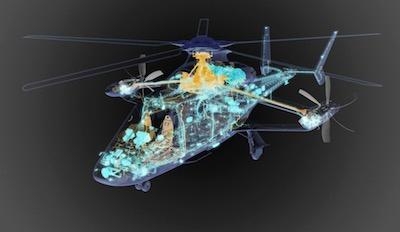Thu, Oct 18, 2018
Aircraft Funded By The European Union’s H2020 Framework Through The Clean Sky 2 Program
Airbus Helicopters continues to progress with the development of its Racer (Rapid And Cost-Efficient Rotorcraft) technology demonstrator, funded by European Union’s H2020 framework through the Clean Sky 2 program, and aiming to provide the best trade-off between speed, cost-efficiency, sustainability and mission performance.

After the validation of the demonstrator’s aerodynamic configuration last year, key subsystems have now successfully passed their preliminary design review (PDR) giving way to the launching of first components manufacture. Final assembly of the prototype is planned to start in Q4 2019.
“I want to thank all of our European partners for the excellence of their work and for their commitment in this fantastic project”, said Tomasz Krysinski, Head of Research & Innovation at Airbus Helicopters. “The PDR marks a major achievement for the Racer program as it allows to freeze interfaces and 3D definitions of the main subsystems, prior to detailed design and manufacture of key components.”
Long-lead items are the first ones to be manufactured. Airbus Helicopters teams already launched production of the lateral drive shaft, one of the Racer’s most innovative components. Among key subsystems, Italy’s Avio Aero, a GE Aviation Business, is launching procurement and manufacturing for the aircraft’s lateral gear boxes housing, while Hamble UK based GE Aviation Integrated Systems is taking care of the wing’s titanium cradle part. Romania’s INCAS/Romaero has already started manufacturing the Racer’s composite side panel and Spain’s Aernnova the tail parts primary structure.
Together with its partners, Airbus Helicopters is currently refining the content of the future Racer flight demonstration in Clean Sky 2 which will begin in 2020 and include about 200 flight hours. The first part will focus on the progressive opening of the flight envelope and on assessing key performance objectives as well as speed, handling qualities, stability and aerodynamics. The second phase will aim at demonstrating the aircraft’s suitability to carry out potential missions where increased speed and efficiency would bring significant added value, such as emergency medical services (EMS), search & rescue (SAR) and private transport. This second flight testing phase will also allow to mature low-noise flight procedures, unique to the Racer demonstrator formula.
(Image provided with Airbus news release)
More News
Mid-Continent Instruments and Avionics and True Blue Power ANN's NBAA 2025 Coverage... Visit Them At Booth #3436 True Blue Power Introduces New 45-watt Charging Ports for 14- and 2>[...]
En Route Automation System (EAS) The complex integrated environment consisting of situation display systems, surveillance systems and flight data processing, remote devices, decisi>[...]
“Our Kodiak aircraft family is uniquely designed to meet the rigorous demands of such deployments, bringing short takeoff and landing performance, robust cargo capacity and e>[...]
Aero Linx: Australian Society of Air Safety Investigators (ASASI) The Australian Society of Air Safety Investigators (ASASI) was formed in 1978 after an inaugural meeting held in M>[...]
Left Main Landing Gear Struck A Bush, And The Right Wingtip Impacted The Ground Analysis: According to the pilot of the tailwheel-equipped airplane, he noticed that the engine oil >[...]
 True Blue Power and Mid-Continent Instruments and Avionics Power NBAA25 Coverage
True Blue Power and Mid-Continent Instruments and Avionics Power NBAA25 Coverage ANN's Daily Aero-Term (10.15.25): En Route Automation System (EAS)
ANN's Daily Aero-Term (10.15.25): En Route Automation System (EAS) Aero-News: Quote of the Day (10.15.25)
Aero-News: Quote of the Day (10.15.25) ANN's Daily Aero-Linx (10.15.25)
ANN's Daily Aero-Linx (10.15.25) NTSB Final Report: Jeremy S Lezin Just SuperSTOL
NTSB Final Report: Jeremy S Lezin Just SuperSTOL



